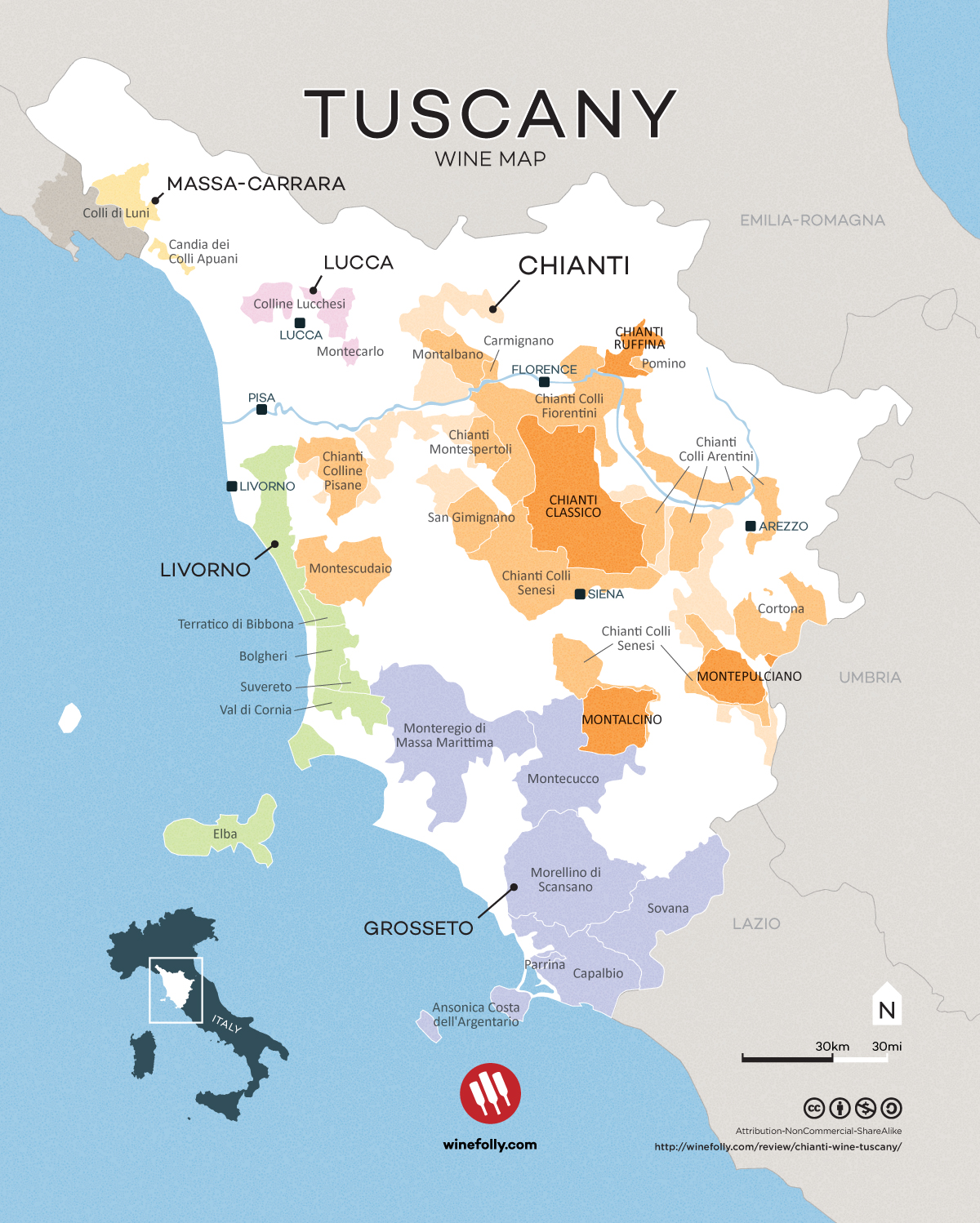Tuscany – It’s more than just Chianti!
Posted on January 19, 2021 in Education


The most well known Italian wine region has to be Tuscany, the home to Chianti. However, Tuscany is a lot more than just Chianti and Chianti is a lot more than the old wicker basket ensconced bottle. The region produces nearly 53 million gallons of wine a year, with the vast majority (~85%) being red. And of these red wines, Sangiovese is the dominant player.
Part of the challenge in discussing Italian wines – or most European wines for that matter – is the nomenclature surrounding the wine. As is typical across Europe, Italian wines are known by the region where they are produced and it is up to the drinker to understand what varietals are actually in the bottle. While you can rest assured that a Cabernet Sauvignon can be called a Napa Cab as long as it has 80+% Cabernet grapes grown in the defined Napa region, what can you divine considering a Chianti vs a Chianti Classico or a Chianti Ruffino? While each has Sangiovese as its base wine and all 3 come from Tuscany, each has different regulations and comes from different areas.
Let’s first discuss the region: Within Tuscany there are nearly 40 sub-appellations containing 11 DOCG, 40 DOC, and 6 IGT classifications. Nearly ⅔ of Tuscan wine production is DOC and DOCG. The most widely known include Chianti, Chianti Classico, Brunello di Montepulciano, Vino di Nobile Montepulciano, Bolgheri, Rosso di Montalcino, Toscano, and Vin Santo. Due to climate, soil composition, and topography, each has its own style and specialty, but Sangiovese remains the dominant red grape across each sub-region.
While regions along the coast, primarily Bolgheri, have lower elevations and are therefore warmer, they are also influenced by the Mediterranean allowing non-native grapes, such as Cabernet and Merlot, to flourish. Further inland it is hilly with some rising peaks producing a cooler growing climate and shifting soil structure. This is where Chianti and most of its sub-appellations are located, and further to the south Montalcino and Montepulciano. These regions are ideal for Sangiovese and some other lesser known indigenous varietals.
Grapes in the bottle: Sangiovese is the base for the majority of the better known wines in Tuscany – Chianti and all its sub-appellations, Brunello, Rosso di Montepulciano, Rosso di Montalcino, and Vino Nobile di Montepulciano. It is a thin-skinned grape, so it makes lighter, translucent wines. In the glass, it is a ruby red color with flashes of bright burnt orange –a hue commonly associated with aged wines. Besides Sangiovese, Chianti wines may contain grapes like Canaiolo, Colorino, Cabernet Sauvignon, and even Merlot, while Brunello is 100% Sangiovese Grosso, a clone of Sangiovese.
Comparing the major red wines from Tuscany:
- Chianti: 70%-100% Sangiovese blended with other varietals; Aged a minimum of 3 months, 9 months for Chianti Superiore
- Chianti Classico: 80%-100% Sangiovese; located in the center of the overall Chianti region; Aged a minimum of 9 months
- Brunello di Montepulciano: 100% Sangiovese Grosso; 2 yrs min cask aging, 5 yrs total aging for release; can age for 20+ yrs
- Rosso di Montepulciano: 100% Sangiovese; Must be aged 1 yr prior to release, cask aging not req’d; some higher qualities considered “baby Brunellos”
- Super Tuscan: Typically a Bordeaux blend; Wines primarily made with non-native varietals e.g., Merlot, Cab Sauv, etc., typically bigger/bolder wines than Sangiovese based wines
Note that each of these wines can have outstanding examples and, while the classifications (DOC, DOCG, IGT) are indicators of quality, you can find something to enjoy across the many offerings. All are ready to drink upon release but will evolve over time and can age for years. Understanding the impact of vintages becomes important if your intent is to cellar any of these wines as it could indicate a cellar life of several years or a few decades! But why wait? Enjoy them soon – younger wines will typically have more fruit and with age more earth tones start to appear. But that is a conversation for a different time!
Cin Cin! 🍷 Salute! 🥂
Sample Wines from Tuscany:
Trambusti Brunello di Montalcino DOCG 2014
Villa Antinori Toscana
Querciabella Mongrana Toscana 2016
Brancaia Ilatraia Toscana 2014
Cecchi Chianti Classico 2017
La Maialina Chianti Classico Riserva 2011
Vignamaggio Gherardino Riserva Chianti 2014
Valdisanti Tolaini Super Tuscan
The Wines of Italy
Resources:
Wine Enthusiast Beginners Guide to Chianti & Chianti Classico
Wines of Central Italy
Italian Wines
